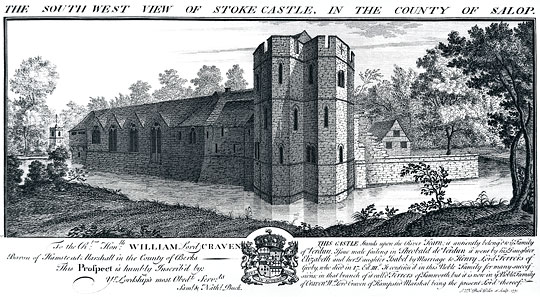Research on Stokesay Castle
The principal source of evidence for Laurence of Ludlow’s buildings at Stokesay is the structures themselves, reinforced by dendrochronology and by a heavy reliance on pictures (themselves not always certainly dated) and much later antiquarian writings.

Research to Date
Apart from a passing reference by Leland in 1539, there are no known references to Stokesay as being worthy of remark before the Buck brothers’ engraving of 1731. A growing number of texts devoted to what may be called antiquarian tourism contain accounts of it, often accompanied by engravings, though the latter could be highly inaccurate.[1]
The written accounts were hampered by historical ignorance, and their grasp of the chronology of the buildings was often faulty – unsurprisingly, since precise factual knowledge of much of the history of Stokesay is still hard to come by.
The necessary understanding emerged unevenly. Although TH Turner gave a careful account of the medieval buildings in 1851,[2] one informed by contextual comparisons, he dated Stokesay’s north tower to the mid-13th century, based on his belief that the architectural style of the neighbouring castle of Acton Burnell, datable to 1284 from a licence to crenellate, was ‘much later’ than that of Stokesay. In this he was followed by several later writers, among them Mrs Stackhouse Acton.[3]
The writings of the Revd James La Touche, vicar of Stokesay,[4] in 1878, brought romanticism to the appreciation of the castle, and his outlook may well have informed the restoration of the castle then in progress. The responses of La Touche’s generation may have led to the domestic function of the castle being overstressed, ignoring the issues of protection against criminals and of status raised by Laurence of Ludlow’s buildings.
As the 20th century progressed, the work of Margaret Wood and RA Cordingley, and more recently of DF Renn, shed valuable light on the physical remains. A reassessment of the medieval nobility and its lifestyle from the 1970s, which led to a new interest in building and landscape as expressions of outlook, had important implications for understanding the aspirations of a man like Laurence of Ludlow.
Chitty, commenting on the ‘designed’ landscape surrounding the castle,[5] and Emery, with his alertness to ‘status intention’ and ‘seignorial prestige’,[6] supply an additional dimension to the appreciation of the castle, which is capable of further development.
Gaps in Knowledge
Written evidence suddenly becomes comparatively full for the Civil War period, but soon relapses and remains scanty thereafter. This is particularly unfortunate for the late 19th century, since it would be fascinating to know both whose outlook is reflected in John Derby Allcroft’s pioneering restoration and who carried out the work.
These shortcomings are not of a kind likely to be redressed. Scraps of information may remain to be discovered among known sources, notably the Earl of Craven’s papers in the Bodleian Library, which still await detailed scrutiny. There may also be useful passing references to be unearthed among the records preserved in Shropshire Archives. But overall there seems to be little chance of a significant cache of previously unknown papers relating to the castle coming to light.
Understanding of the castle structure can probably only be advanced in the near future by a detailed and informed examination of the surviving buildings, and perhaps also by archaeological investigation and resistivity surveys. These may be the only means of discovering anything about the original gatehouse, or of determining whether the moat was ever intended to be filled with water.
More generally, historiographical developments are always likely to have repercussions for the way Stokesay is seen, by altering perceptions of the context in which the castle functioned.
READ MORE ABOUT STOKESAY CASTLE
Footnotes
1. For example, the engraving accompanying Francis Grose’s description of 1785 shows the gatehouse as made of stone: F Grose, Antiquities of England and Wales, vol VIII (1787), facing 121.
2. TH Turner, Some Account of Domestic Architecture in England from the Conquest to the End of the Thirteenth Century, 2 vols (Oxford, 1851–3), 1.157–61 (accessed 28 Sept 2012).
3. Eg F Stackhouse Acton, ‘Stokesay’, Archaeologia Cambrensis, new series, 4 (1853), 39–42.
4. JD La Touche, ‘Stokesay Castle’, Transactions of the Shropshire Archaeological and Natural History Society, 1 (1878), 311–32.
5. Details of which, in the form of ponds and watercourses, have been revealed by aerial photography.
6. A Emery, Greater Medieval Houses of England and Wales, 1300–1500: East Anglia, Central England and Wales, vol 2 (Cambridge, 2000), 574–6.